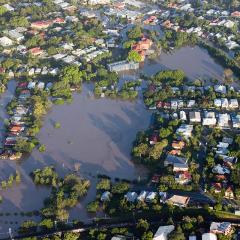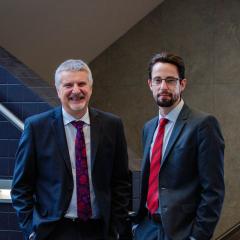Professor Sue Kildea believes research can be a great change management strategy.
Her current Water Birth Study at the Mater is a case in point.
“Women weren’t able to have water births at the Mater due to a lack of evidence, but they can in the water birth study,” she says.
The Water Birth research project is assessing a new procedure for the hospital for birthing. The use of warm water immersion during labour is known to provide comfort by allowing easier movement, pain reduction, and the speeding up of the first stage of labour. However, water birth is much more controversial, making it ideal for a research study.
It is not the only study Professor Kildea is investigating that utilises water for pain relief in childbirth.
Together with UQ colleague Dr Nigel Lee, Professor Lena Mårtensson and Professor Ingrid Bergh of University of Sweden, and McMaster University's Professor Eileen Hutton, she is researching the use of sterile water injections for pain relief.
One of their studies is already up and running in 14 hospitals across Australia, with a trial site recently established in Oxford, UK.
The objective of the current research is to determine if sterile water injections, as an intervention for back pain in labour, will reduce the caesarean section rate.
“Honestly, they’re like magic pills! They are very painful for about 20 seconds to a minute, but they remove pain for up to two hours. Then you can administer more injections when required,” she says.
“Not only does it reduce the pain but it could reduce the C-section rate. We think that what happens is the minute they take the pain away all those tense muscles actually relax and start doing their job properly so that the baby can be born.
“We opened up trial sites in a number of Queensland hospitals, but none of the midwives wanted to randomise women in case they didn’t receive sterile water injections because they all believe it works. They wanted it for everyone! So we had to go interstate and overseas to hospitals where they aren’t allowed to be given.”
Professor Kildea is proud of the work she and her colleagues are doing in this field: “Arguably, we’re the group doing the most research on this.”
The reoccurrence of water in her research may be a coincidence, but she’s also part of a longitudinal study which involves the Queensland floods of 2011.
SPIRAL is the Stress in Pregnancy International Research Alliance, or as Professor Kildea calls it “the wind, water, and ice study”.
The program is aimed at increasing understanding of how maternal stress from natural disasters affects the fetus during pregnancy, and the growth and development of the child.
The study involves women who were pregnant during the January 1998 ice storm in Quebec, the Iowa flood of 2008, and our flood of 2011. Another cohort was added to the study after last year’s devastating cyclone in Vanuatu.
“Each (natural disaster) has their own unique factors to study – what we’ve got from the 2011 floods some of the others haven’t got. We’re building a database of quite unique features.”
With a recent application for funding it is hoped the SPIRAL project will continue for another seven years.
It is clear Professor Kildea is passionate about health services research and improving care for women during pregnancy and labour but her biggest area of interest, and concern, is in making a difference to the lives of Aboriginal and Torres Strait Islander families.
“There has been policy after policy that has recognised that we’re not providing culturally safe, responsive care to our Aboriginal and Torres Strait Islander Australians. That’s been well documented for 30 years. Many of those documents have said we should trial Birthing on Country in remote areas in the way that the Inuit have done it because their outcomes are amazing, and we could see the same improvements here.”
While Professor Kildea expresses disappointment in the lack of outcomes from the National Maternity Services Plan – a five year plan released in 2010 that led to a national workshop on Birthing on Country and a resultant report recommending services that enable Indigenous women in remote areas to give birth in their communities – she is hopeful of a reform of maternity services.
“Birthing on Country is seen as a metaphor for the best start in life for Aboriginal and Torres Strait Islander Australians. To implement it requires system reform. We need to be brave, we need to be supportive of Indigenous women and their families and what they want. We have to go forward with the Birthing on Country work. If we want to close the gap we need governments who are prepared to do things differently, who are going to listen to the community. Aboriginal organisations need more control. It needs to be a holistic approach, a whole of community approach, one that brings in support for culture being at the centre of care, where Indigenous students are well supported to do midwifery training.”
Professor Kildea is playing an important role in bringing about these changes.
“We have developed a partnership with the Institute of Urban Indigenous Health, the Aboriginal and Torres Strait Islander Community Health Service and the Mater Health Service to work together to make a difference. Yes, of course it is another research project!” she laughs.
“UQ and the Mater funded a clinical chair in midwifery, which puts me in the community. You can effect change in this research setting. It is health services research. It’s messy, it rarely goes the way you want it to, but when you try you can help make a difference. There’s never a dull moment, and we have a lot of fun making it work!”
Along with clinical research, Professor Kildea guest lectures to midwifery and nursing students and supervises Masters and PhD students. She is particularly enthusiastic about the newly refurbished Whitty Building.
The 105-year-old heritage listed building in South Brisbane recently underwent a $30 million redevelopment as a result of an alliance between The University of Queensland and Mater Health Services. The Whitty Building collaboration – to allow for delivery of customised UQ/Mater nursing and midwifery programs – is the first of its kind in Australia.
“It’s fantastic. It’s on the ground, in the coalface. We’ve got the students and the academics on site, in the hospital. The more you have students on site, the more they become our students, the students of the health service. Once they become our students they get their own sense of ownership. It’s a great thing having them here and working with the next generation of health care providers.”
Professor Sue Kildea holds a Clinical Chair in Midwifery and is the Inaugural Director of the Midwifery Research Unit, a collaboration between the Mater Health Services, the Mater Research Institute, UQ and the UQ School of Nursing, Midwifery and Social Work. Her expertise lies in introducing and evaluating innovative models of maternity service delivery, leading research across distances, strengthening rural and remote maternity services, care provision for Aboriginal and Torres Strait Islander families, care that promotes normal birth and translating research into practice.
Words: Dani Nash
Photos: Anjanette Webb




